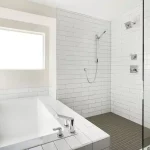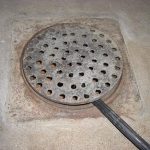If you’re experiencing frustration with your washing machine and sink draining system, don’t worry – there may be a simple fix. It’s common for washing machines to share a drain with the utility or kitchen sink, but sometimes this can cause problems such as backing up. Understanding how the system works and why it may be backing up is the first step in finding a solution.
One reason why the washing machine drain hose to sink may fail to work is due to improper venting or blockage inside the pipes. To identify the reason, you’ll need to observe the entire draining system. If the water is restricted due to blockage, a plunger may be used to remove the clogs from the pipe. Keep reading to learn more about how to troubleshoot and fix issues with your washing machine and sink draining system.
Washing Machine Drains Into Sink: Is It Possible?
If you are in a situation where you need to install a washing machine in your basement without a proper drainage system, you may consider draining it into the sink instead. By using a special hose to connect the utility sink with the washing machine, both appliances can drain into the same plumbing system.
To connect the sink and washing machine with the hose, you will need to secure it using wire ties or traditional brackets. Additionally, you may want to install a homemade filter at the end of the drain hose to prevent clogging and backups. However, it’s important to note that the hose may still back up and cause overflows, so it’s crucial to identify the reasons why.
There are a few options when it comes to choosing a washing machine drain hose to sink. The rubber drain hose is an affordable alternative that can connect your washing machine with the main draining or utility sink. A newer rubber drain hose has rayon or braided mesh to strengthen the hoses. However, if you want the best drain hose for connecting washing to the sink, you should choose the braided stainless steel washing hose. It can handle the workload to drain larger washing machines perfectly.
When selecting a hose, keep in mind that it will depend on the distance between the appliance and the sink. You may need to measure the distance to ensure that you get the right length of hose.
Overall, it is possible to drain a washing machine into a sink, but it’s important to use the proper hose and secure it correctly to prevent backups and overflows.
Why Is My Washing Machine Draining Into My Sink?
When you notice that your washing machine is draining into your sink instead of the main sewer line, you may get panicked. However, this problem can occur due to several reasons. In this section, we will discuss the three most common causes of this issue.
Clogged Drainage Pipe:
If your washing machine and utility sink share the same drainage pipe, clogs can often stop the system from working properly. The debris, gunk, and residue from the utility sink can accumulate inside the draining pipe, leading to a partial blockage. You must locate where the clog has happened. If the clog has happened before the utility sink, you will see the water backing up from your washing machine drain. If the clog has happened after the utility sink and washing machine hose connection, you will see the water backing up in the lowest fixtures.
To eliminate the clog, you may use a plunger. First, you need to fill the sink with enough water to cover the plunger’s bell. Then, place the plunger over the drain and pump it up and down for 20-30 seconds. Repeat this process until the clog clears.
Problems in the Vent:
The vent is responsible for providing enough air supply to the drain and water line pipes. When there’s a problem with the venting system, it affects the drainage system of your appliance and utility sink. If you have installed the wrong size vent or one side of the vent has been plunged, the vent fails to supply adequate air pressure. As a result, you may hear a loud gurgling sound when the water drains through the pipes.
Birds’ nests or debris on the vent opening can also prevent the air from flowing through the vents. It will result in the lack of the right air pressure to the main draining pipe. It is a problem because through it your utility sink and washing machine will drain.
Problems with the Drain:
If the drainpipe is undersized, it may not be able to handle the increased draining rate of the washing machine. A standard washing machine will pump 15 gallons of water through the drainpipe. The draining rate will increase with the size of your washer and the washing speed you have set with the device. Thus, you need the right-sized draining pipe to tackle the increased draining rate of the appliances.
A drain pipe needs to be at least 1-1/2 inches in diameter to drain the washing machine water properly. Nowadays, many building codes require you to install a 2-inch drain pipe. Therefore, when you see that the water is backing up instead of draining, you must check the drain pipe size. If it is undersized than the suggested one, you may need to replace it. Changing the drain pipe will require you to remove and redo the drywall, so you will have to call a plumber.
In conclusion, when your washing machine is draining into your sink, it can be due to clogged drainage pipes, problems in the vent, or problems with the drain. By following the above steps, you can diagnose and fix the problem quickly and efficiently.
How Do I Stop My Washing Machine Backing Up Into My Sink?
If you’re experiencing water backup from your washing machine into your utility sink, you need to fix it right away to prevent flooding. Here are the steps you can take to stop the water from backing up:
Method 1: Remove the Clogs
Most of the time, clogs in the pipe and P-trap cause water from the washing machine to backup instead of draining into the main sewer line. To unclog the pipe, follow these steps:
- Identify where the clog has occurred and clear it. You can use a plunger to unclog the P-trap and drain pipe. If the clog is too deep down inside the pipe, use a long plumbing snake.
- Turn off the main water line before using the plunger or plumbing auger. Also, turn off the utility sink faucet.
- Wait for a few moments so that there’s no water inside the main supply line. Then, open the stopper of the utility sink to access the drain pipe.
- The stopper of the sink will be connected with bolts underneath the sink. Reach beneath the sink and remove the bolts using an Allen wrench or screwdriver. You can insert the plunger inside the draining pipe when you have removed the stopper.
- Continue inserting the pipe unless it gets stuck with the clogs. Turn the plunger or plumbing snake to collect the clogs. You will need to repeat the process of inserting the plunger and collecting the clogs until it is fully cleared.
Once you have removed the clogs, reinstall the stopper and turn on the waterlines.
Method 2: Fix the Vents
If the washing machine is backing up due to problems with the vents, you will need to fix them. However, fixing the vents may not be easy for most homeowners, so we suggest calling a professional.
To fix the vents, follow these steps:
- Check the opening of the vents on your roof. There might be debris or even a bird’s nest. Remove the bird’s nest or residual build-ups from the vent opening to help air pass through it properly.
- If you have the wrong sized vent, you may need to replace it, which can be costly.
By following these methods, you can prevent your washing machine from backing up into your sink.
Frequently Asked Questions:
Can a washing machine and sink share a drain?
Yes, it is possible for a washing machine and sink to share a drain. The vent lines are typically located close to each other, and you can use a tie wire to secure the washing machine hose to the sink. However, it is important to make sure that the drain can handle the additional water flow and that there are no clogs in the waste trap.
Can washing machine waste go into sink waste?
Yes, you can connect the washing machine waste to the same waste trap as your kitchen sink. It is important to ensure that the waste trap is not clogged and is functioning properly. This will prevent any blockages in the drain and ensure that the water flows smoothly.
Does a washing machine drain need to be vented?
Yes, it is necessary to install a vent for the washing machine drain. This is required by building codes and plumbing regulations in many areas. The vent helps to ensure that the water flows properly through the drain pipe. It is important to mount the vent correctly to avoid any issues with water flow or drainage.
Conclusion:
In conclusion, it is important to secure the connection between the washing machine and the sink to prevent any water backup. Regularly checking and unclogging the drain pipe is also crucial to ensure the smooth functioning of the plumbing system.




